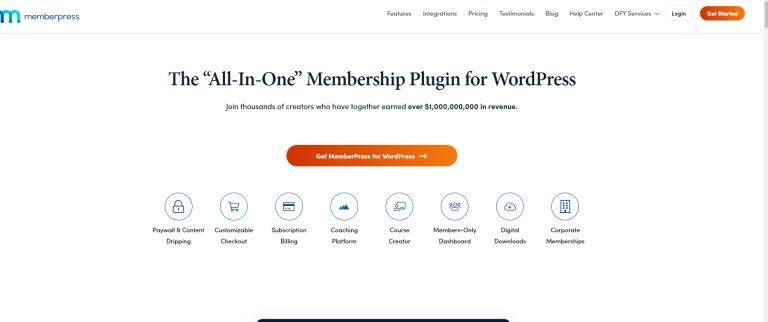9 Proven Membership Retention Strategies for 2025

Keeping your members happy and engaged is a huge part of running a successful online community or education business.
It’s easy to focus all our energy on attracting new people, but what about the amazing members who have already committed to your program? Losing someone always feels tough, and frankly, it’s far more expensive to find a new member than to keep an existing one.
Let’s look at nine powerful strategies that will give your members every reason to stay and grow with you.
1. Personalized Onboarding Experience
The first 48 hours of a new member’s journey are critical.
A generic “welcome” email just isn’t enough anymore. A personalized onboarding experience is one of the most effective membership retention strategies because it immediately shows value and tells new members that you understand their unique needs.
You need to guide them to their first “aha!” moment as quickly as possible, ensuring they feel seen, understood, and confident they made the right choice.
This process involves tailoring the initial interactions, content, and recommended actions based on the member’s goals, experience level, or role.
Instead of a one-size-fits-all tour, you create specific pathways that lead them directly to the resources most relevant to them.

Why It Works So Well
A strong, personalized welcome combats the initial overwhelm many new members feel.
By pointing them toward a specific “quick win,” you build their confidence and create positive momentum. This early engagement makes them significantly more likely to integrate into the community, consume your content, and ultimately, renew their membership when the time comes. It sets the foundation for a long-term, loyal relationship.
How to Implement This Strategy
Creating this experience doesn’t have to be overly complex. You can start with small, impactful steps.
Segment at Signup: Ask a simple question during the registration process, like “What is your primary goal?” or “What’s your current experience level (Beginner, Intermediate, Advanced)?” Use their answer to trigger a tailored welcome email series.
Create Role-Based Paths: HubSpot Academy provides different learning tracks for marketers versus salespeople, and you can do the same. Create onboarding checklists for different member types. A “newbie” might get a foundational video series, while an “expert” might be directed to an advanced masterclass or a special interest group.
Celebrate Quick Wins: Design the first week to include an easy-to-achieve milestone. This could be completing a profile, introducing themselves in a specific forum thread, or finishing a short introductory lesson. Acknowledge this with a congratulatory email or a special badge.
2. Gamification and Achievement Systems
We’re all wired to enjoy progress, achievement, and a little friendly competition. Gamification taps directly into these motivators by applying game-like elements to your membership experience.
This is one of the most powerful membership retention strategies because it makes engagement fun, rewarding, and even a little addictive. It transforms tasks like completing a course or participating in a discussion into an exciting journey with clear milestones.
This strategy involves integrating systems like points, badges, leaderboards, and progress bars into your community or learning platform.
Instead of just consuming content, members are on a quest. They are actively working towards tangible rewards and recognition, which keeps them coming back day after day.
Why It Works So Well
Gamification creates a compelling feedback loop. When a member earns a badge for contributing to a forum or a “streak” for logging in five days in a row, their brain gets a small hit of dopamine. This positive reinforcement encourages repeat behavior.
Leaderboards foster a sense of community and friendly competition, while progress bars show members how far they have come, motivating them to reach the finish line. It turns passive members into active, invested participants.
How to Implement This Strategy
You can start small and build a more complex system over time. The key is to reward the behaviors that lead to long-term member value and retention.
Reward Key Actions: Identify the most important actions a member can take, such as finishing a lesson, commenting on a post, or uploading a project. Assign points or unlock a specific badge for each of these actions. Duolingo does this perfectly by rewarding users for daily streaks and completing lessons.
Start with Easy Wins: Make the first few achievements very easy to unlock. This could be a “Profile Complete” badge or “First Comment” points. This provides instant gratification and shows new members how the system works, creating early momentum that encourages deeper engagement.
Introduce Challenges and Leaderboards: Create weekly or monthly challenges that encourage participation, like a “Top Contributor” challenge. Display a leaderboard to showcase your most active members. This taps into social motivation and can significantly boost activity, similar to how the Nike Run Club uses challenges to get people moving together. You can learn more about how to apply gamification for elearning on learnstream.io.
Create Tiers and Levels: As members accumulate points, allow them to “level up” to new tiers. Each tier can unlock new perks, like access to exclusive content, a special title in the community, or even a discount on their renewal. The Starbucks Rewards program is a classic example of this tiered progression.
3. Data-Driven Member Health Scoring
Predicting who might leave your membership before they even think about canceling is a powerful capability.
A data-driven member health score is a proactive membership retention strategy that quantifies engagement and satisfaction levels to identify at-risk members. It helps you move from reactive problem-solving to a predictive model that lets you intervene with the right support at the right time. This can turn a potential churn into a saved member.
This system works by assigning a score to each member based on their behaviors. You track key actions like login frequency, course completion rates, community participation, and even support ticket submissions.
By putting these data points together, you create a single, clear metric that tells you, at a glance, how healthy and engaged each member is.
This is similar to how Netflix analyzes viewing patterns to keep subscribers hooked or how Salesforce scores customer health to prevent platform abandonment.

Why It Works So Well
A member health score removes the guesswork from your retention efforts. Instead of waiting for a member to complain or go silent, you have an early warning system.
When a score drops below a certain threshold, it can trigger an automated alert for your team. This allows you to reach out with a personal email, offer help, or guide them to a valuable resource they may have missed. This can effectively prevent them from becoming disengaged and churning.
How to Implement This Strategy
Getting started with health scoring can be straightforward. You don’t need a complex algorithm from day one.
Define Your Metrics: Identify the key actions that signal a healthy member in your community. This could be logging in at least once a week, commenting on 3+ posts per month, or completing a new module within 14 days of its release. Assign points to each action.
Set Up Score Thresholds: Create clear tiers for your scores. For example, 80-100 might be “Healthy,” 50-79 could be “At-Risk,” and below 50 is “Critical.” These thresholds will guide your response.
Automate Your Interventions: Use your membership platform or email marketing software to create automated workflows. A member dipping into the “At-Risk” category could receive a friendly email asking, “We miss you! Here’s a new masterclass we think you’ll love.” A “Critical” member might trigger a notification for a team member to make a personal phone call.
Regularly Validate Your Model: Check your health scores against actual renewal and churn data every quarter. Are the members you identified as “at-risk” actually the ones leaving? Adjust your scoring metrics to make your predictions more accurate over time.
4. Community Building and Peer Connection
Members might join for your content, but they will stay for the community. Fostering an environment where members can connect, interact, and build genuine relationships with each other is one of the most powerful membership retention strategies you can deploy.
This creates a sense of belonging and mutual value that transforms your membership from a simple transaction into an indispensable part of their personal or professional lives.
This strategy involves creating opportunities for peer-to-peer connection. Your role shifts from being the sole source of value to being the facilitator of a thriving ecosystem.
When members forge their own connections, the value of their membership multiplies, and the community itself becomes a primary reason for renewal.

Why It Works So Well
A strong community creates powerful network effects and deep emotional investment. Members who feel connected to others are less likely to leave. They would lose not just access to content but also their network of peers, friends, and collaborators.
This social fabric, seen in platforms like Peloton with its group workouts or GitHub with its developer collaborations, makes the membership “sticky” and deeply integrated into a member’s daily routine.
How to Implement This Strategy
You can intentionally design your space to encourage these vital connections. It starts with creating the right structure and prompts.
Seed Conversations and Ask Questions: Don’t wait for conversations to happen organically. Post engaging questions, share valuable content to spark debate, and create daily or weekly discussion threads. Your initial effort will model the kind of interaction you want to see.
Recognize and Reward Contributors: Identify your most active and helpful members. Publicly acknowledge their contributions, give them a special badge or title, or even invite them to be community moderators. This recognition encourages continued participation and inspires others to get involved.
Facilitate Targeted Introductions: Use the data you gathered during onboarding to connect members with common interests, goals, or geographic locations. You can do this through dedicated “introduction” threads, small mastermind groups, or by creating exclusive spaces for different member segments, such as “Beginners” or “Advanced Practitioners.” For more ideas, you can learn how to build community in an online course.
5. Value-Based Communication Cadence
Bombarding members with constant promotions is a surefire way to see your unsubscribe rates climb.
A value-based communication cadence is one of the most powerful membership retention strategies because it shifts the focus from selling to serving.
This approach centers on delivering consistent, high-value content that helps your members achieve their goals. It also keeps your brand top-of-mind for positive reasons.
Instead of just announcing new products or upcoming renewal dates, you establish a reliable rhythm of communication that members actually look forward to. Think of it like a trusted friend who always shares the best resources.
This could be a weekly insights email, a monthly expert Q&A, or curated content that solves a common problem for your audience. The key is consistency and a relentless focus on member value.
Why It Works So Well
This strategy builds trust and reinforces the value of the membership long before the renewal notice ever goes out.
When members regularly receive helpful advice and exclusive content from you, they see their subscription as an ongoing investment in their success, not just a one-time purchase. It keeps them engaged between logins and ensures they never question what they’re paying for.
How to Implement This Strategy
A successful communication cadence is planned, not improvised. It provides a steady stream of value that becomes part of your member’s routine.
Segment Your Communications: Don’t send every email to every member. Use tags or segments based on interests, course enrollment, or engagement level to send highly relevant content. A beginner might get foundational tips, while an advanced user receives a case study on a complex topic.
Create Exclusive “Members-Only” Content: Make sure your communications include resources that are not available to the public. This could be a downloadable worksheet, a bonus video tutorial, or early access to a new feature. This exclusivity reinforces the premium nature of the membership. For example, Shopify regularly sends its merchants educational content and trend reports to help them succeed.
Optimize Your Frequency and Timing: Use your email marketing data to see what works. Do you get more opens on Tuesday mornings or Thursday afternoons? Test different cadences, like weekly versus bi-weekly, to find the sweet spot that keeps members engaged without overwhelming their inboxes. Always put the core value proposition in the subject line to grab their attention.
6. Exclusive Benefits and Early Access Programs
People love feeling special, and a well-designed benefits program can make your members feel like true VIPs.
Offering exclusive perks and early access is one of the most powerful membership retention strategies because it directly increases the tangible value of sticking around. It transforms a simple transaction into a privileged status, creating a compelling reason for members to renew year after year.
This approach is about giving your loyal community access to content, opportunities, or discounts that the general public cannot get.
Think of Amazon Prime’s early access to deals or a professional association offering its members first dibs on conference tickets. It creates a clear “in-group” and makes the membership fee feel like a small price to pay for the exclusive advantages.
Why It Works So Well
This strategy taps directly into the psychological principle of exclusivity and the fear of missing out (FOMO).
When members know they are getting something others can’t, it reinforces the value of their decision to join.
These perks become a core part of the membership identity, making it much harder to leave and lose that special status. It’s a constant, tangible reminder of why their membership is worthwhile.
How to Implement This Strategy
You can introduce exclusivity without a massive budget. The key is to offer something that is highly valuable to your specific audience.
Create Tiered Access: A great starting point is to offer different levels of exclusivity. Your top-tier members could get early access to new courses a week before anyone else, while a lower tier might get an exclusive monthly Q&A session with you. This creates an aspirational path for members to upgrade.
Provide Early-Bird Opportunities: Give members the first chance to buy tickets for live events, workshops, or limited-enrollment masterclasses. This is a low-cost, high-value perk that rewards loyalty. For instance, Disney’s D23 fan club members often get presale access to major event tickets.
Offer Exclusive Content: Don’t release everything to the public. Create bonus content, like behind-the-scenes videos, extended interviews, or downloadable templates, that are only available to paying members. Promote this content prominently so non-members see what they are missing.
7. Proactive Customer Success Management

Moving beyond reactive support tickets is a game-changer for retention.
Proactive customer success management is one of the most powerful membership retention strategies because it focuses on ensuring members achieve their goals from day one.
This dedicated approach involves guiding members toward their desired outcomes with strategic check-ins, success planning, and obstacle removal before they even think about leaving.
This approach is about more than customer service. It’s about a dedicated individual or team, often called a Customer Success Manager (CSM), whose primary job is to advocate for the member’s success.
They use data and regular communication to make sure members are getting the full value out of their subscription, actively helping them use your resources to achieve what they signed up for.
Why It Works So Well
When members feel like they have a dedicated partner invested in their success, their loyalty skyrockets. This proactive relationship builds deep trust and transforms your membership from a simple product into an essential partnership.
By anticipating needs and clearing roadblocks, you prevent the frustration and disengagement that lead to churn. Members who achieve their goals are your happiest, most vocal advocates and are almost certain to renew.
How to Implement This Strategy
You don’t need a massive team to start. You can implement the principles of customer success even as a solo creator.
Assign CSMs Strategically: If you have a team, assign CSMs to your highest-value or most complex membership tiers. For solo operators, you could offer “Success Coaching” as a premium add-on or dedicate a few hours each week to proactively check in with your newest or highest-potential members.
Use Data to Time Outreach: Monitor member activity. If a new member hasn’t logged in for a week, or if an active member stops engaging with key features, trigger a friendly, non-automated check-in. A simple “Hey, saw you haven’t started the advanced module yet, can I help you get set up?” can make all the difference.
Create Success Plans: During onboarding or a “kick-off” call, work with the member to fill out a simple success plan. This template should outline their primary goals, the key milestones they need to hit, and which of your resources will help them get there. Review this plan with them quarterly.
8. Flexible Membership Options and Customization
Not all members are created equal, and their needs, budgets, and circumstances can change over time. Forcing everyone into a single, rigid membership plan is a recipe for churn.
Offering flexible membership options is one of the most powerful membership retention strategies because it gives members a sense of control. It also allows them to align your offering with their exact situation.
You need to create a system that can adapt to a member’s life, rather than forcing the member to adapt to a system.
This approach involves creating multiple tiers, payment schedules, and feature sets. By providing choices, you lower the barrier to entry.
More importantly, you create pathways for members to stay even when their financial or time commitments shift. It acknowledges that a member’s journey isn’t always a straight line.
Why It Works So Well
Flexibility reduces friction and pre-empts cancellations. When a member’s only options are to pay the full price or leave, many will choose to leave, even if they’d prefer to stay in a limited capacity.
By providing a downgrade option or a payment pause, you keep them in your ecosystem. This prevents churn and gives you an opportunity to win them back to a higher tier later.
This strategy shows empathy for your members’ situations, which builds significant trust and goodwill.
How to Implement This Strategy
Implementing flexibility requires a thoughtful approach to your membership structure. You want to offer choice without causing confusion.
Limit to 3-4 Tiers: To avoid overwhelming potential members, stick to a few clearly defined options. Think like Adobe Creative Cloud, which offers single-app subscriptions versus the full suite. A common model is a basic, a standard, and a premium tier, each with escalating value.
Offer a Downgrade Path: When a member clicks “cancel,” don’t let that be the end of the road. Offer them a chance to downgrade to a lower-cost tier or a “maintenance” plan with limited access. This is a crucial retention tool that keeps the relationship alive.
Provide Payment Flexibility: Consider offering both monthly and annual payment options. An annual plan can be discounted to incentivize a longer commitment and improve your cash flow, while a monthly plan offers a lower initial barrier for new sign-ups.
Introduce a “Pause” Feature: Life happens. Members might travel, face a busy period at work, or have a temporary financial issue. Allowing them to “pause” their membership for 1-3 months, like many modern gyms do, is far better than losing them completely.
9. Retention-Focused Renewal Process
Treating the renewal period as a mere transaction is a missed opportunity. An effective renewal process is a core part of your membership retention strategies, beginning long before the expiration date.
It should be a thoughtful, value-driven conversation that reinforces the benefits of staying, not just a series of payment reminders. This approach reframes renewal as the natural next step in a successful, ongoing relationship.
Instead of a last-minute scramble to prevent churn, this strategy involves a systematic campaign designed to remind members of the value they’ve received and the value yet to come.
You’re proactively demonstrating worth and making the decision to renew an easy and enthusiastic one. By building a proper sales funnel for your membership site, you can automate much of this value-driven communication.
Why It Works So Well
A retention-focused process eliminates the sticker shock and uncertainty that often leads to churn. By starting the conversation early, you have ample time to address concerns, showcase achievements, and remind members why they joined in the first place.
This proactive engagement makes members feel valued and appreciated. It transforms the renewal from a purely financial decision into an emotional and logical one. It builds loyalty and significantly reduces passive, or accidental, churn.
How to Implement This Strategy
Shift your renewal process from a transaction to a celebration of your member’s journey.
Start the Conversation Early: Begin the renewal sequence 90 days before the expiration date. The first communication shouldn’t even ask for money. Instead, it can be a “look back” email celebrating their progress or engagement over the past year.
Create Personalized Value Reports: Professional associations like the IEEE send members a report detailing their engagement, and you can create a simple, personalized summary too. Highlight courses they completed, community discussions they participated in, or resources they downloaded. This tangibly proves the ROI of their membership.
Offer Smart Renewal Incentives: Encourage early renewals by offering a meaningful perk. This could be a bonus month of membership, access to an exclusive masterclass, or a small discount. This rewards loyalty and improves your cash flow predictability.
Deploy Cancellation Prevention Specialists: For members who indicate they won’t renew, have a dedicated person or process to engage them. The goal isn’t to be pushy but to understand their reasons, solve any issues if possible, and gather crucial feedback to improve your program.
Membership Retention Strategies Comparison
| Strategy | Complexity | What’s Required | Expected Outcomes | Ideal Use Cases |
|---|---|---|---|---|
| Personalized Onboarding Experience | High (content creation & updates) | Significant upfront & ongoing content and staff involvement | Faster time-to-value, higher early engagement | New member integration, diverse member needs |
| Gamification and Achievement Systems | Medium to High (design & maintenance) | Ongoing system updates, reward management | Increased engagement, motivation, participation | Engagement-driven communities, activity increase |
| Data-Driven Member Health Scoring | High (data infrastructure, analytics) | Significant data and technical investment | Proactive retention, prioritized outreach | Large member bases requiring churn reduction |
| Community Building and Peer Connection | Medium (management & moderation) | Ongoing moderation and facilitation resources | Strong member bonds, organic knowledge sharing | Networks emphasizing peer-to-peer interaction |
| Value-Based Communication Cadence | Medium (content creation & segmentation) | Continuous high-quality content creation | Maintained top-of-mind presence, trust building | Organizations focusing on educational engagement |
| Exclusive Benefits and Early Access Programs | Medium (benefit management) | Continuous innovation & partnership development | Increased perceived value, differentiation | Premium memberships, VIP experiences |
| Proactive Customer Success Management | High (human resources & expertise) | Dedicated CSMs, training, coordination | Reduced churn, increased upsell, issue prevention | High-value or complex memberships |
| Flexible Membership Options and Customization | Medium (billing & product complexity) | Systems for billing flexibility and options | Reduced churn from life changes, revenue optimization | Diverse member needs and budgets |
| Retention-Focused Renewal Process | Medium to High for coordinating and personalizing | Staff time for outreach, tracking systems | Improved renewal rates, relationship strengthening | Organizations with recurring membership cycles |
Building a Membership That Lasts
We’ve covered a lot of ground, exploring nine powerful membership retention strategies that can transform your community from a revolving door into a thriving, long-term ecosystem.
The journey from a new sign-up to a loyal advocate is paved with intentional, value-driven interactions. The core idea tying all these tactics together is a fundamental shift in perspective. Retention should be the central focus of the entire member experience.
You’re building a relationship, not just providing content. When you proactively manage customer success and foster genuine peer-to-peer connections within your community, you create an environment that becomes indispensable to your members.
From Theory to Action: Your Next Steps
Reading through a list of strategies is one thing, but putting them into practice is where the real magic happens. It can feel overwhelming to try and implement everything at once, so I encourage you to avoid that temptation. Instead, let’s focus on taking clear, manageable steps forward.
Here’s a simple action plan to get you started:
Choose Your “One Thing”: Look back at the nine strategies. Which one resonated the most with you? Which one addresses the most significant pain point you’re currently facing? Is it the lack of engagement that a gamification system could solve? Or perhaps a clunky renewal process is causing unnecessary churn. Pick just one strategy to focus on for the next 90 days.
Conduct a Member Survey: You can’t improve what you don’t understand. Create a short, simple survey to get a pulse on your community. Ask them what they value most, what they wish they had more of, and why they stick around. Their answers will provide invaluable clues on where to direct your efforts. This feedback is the foundation of effective membership retention strategies.
Map Your Member Journey: Grab a whiteboard or a digital tool and visually map out the entire experience from the moment someone signs up to their one-year anniversary. Identify the key touchpoints. Where are the moments of delight? More importantly, where are the potential points of friction where members might lose interest and drift away? This map will reveal your biggest opportunities for improvement.
The True Value of Retention
Mastering these concepts helps you build a sustainable, impactful business. It’s about more than just boosting your revenue and reducing churn rates, although those are fantastic outcomes.
A loyal, engaged community becomes your greatest asset.
Your most dedicated members are not just customers, they are your best marketers, your most honest critics, and your most passionate co-creators.
When you invest in retaining them, they invest back into your community. They provide testimonials, refer new members, offer constructive feedback, and help create the vibrant culture that attracts even more people.
This positive feedback loop is what separates good membership sites from truly great ones. It reduces your customer acquisition costs and creates a powerful brand moat that competitors simply can’t replicate.







